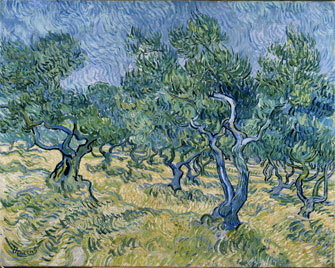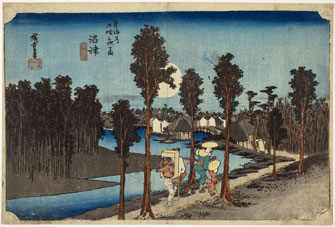Japan Imagined by
Hiroshige and Van Gogh

Van Gogh’s ”Oliveraie” (1889). © Collection Kröller-Müller Museum, Otterlo, the Netherlands
The Pinacothèque de Paris has just opened two complementary exhibitions, “Hiroshige, l’Art du Voyage” and “Van Gogh, Rêves de Japon.” The first presents two series of prints by ukiyo-e master Utagawa Hiroshige (1797-1858), who is described by the curator as the Japanese Leonardo da Vinci: “The Fifty-Three Stations of the Tokaido Road” and “The Sixty-Nine Stations of the Kisokaido Road,” which follow two different routes between Edo (today’s Tokyo) and Kyoto. Each stops at post stations along the way to show famous sights and the local scenery, and to document the trials, tribulations and joys of travelers along the famed routes. According to the exhibition’s catalogue, Hiroshige probably based most of these images on existing guidebooks rather than his own travels, but that in no way detracts from their beauty and interest to us today.
While all of these prints can be found online (here and here), nothing can replace seeing them in person, so you can appreciate their vibrant colors, most notably the joyous blues, and marvelous compositions. According to the exhibition’s curator, these series were meant to inspire serene, meditative inner voyages as much as to incite viewers to actually take to the road.
You can see from these prints that travelers’ experiences weren’t so very different in 19th-century Japan from what they are today: they, too, get soaked in driving rain and shop at souvenir stands selling local knick-knacks near famous sites.
Hiroshige had absorbed the rules of Western perspective, but he sometimes offers unusual
“Un Pèlerin avec un Large Masque Sarutahiko sur les Rives du Fleuve Kano.” © Museum Volkenkunde, Leiden/
Musée National d’Ethnologie, Leyde, inv. 1353-25-13
viewpoints: we see one scene, for example, through the legs of horses, huge in the foreground of the picture. The most beautiful of these prints, however, are the starkest and simplest.
The exhibition is rounded out with Japanese travel equipment of the time: a little case that doubles as a pillow, a tea-making kit, a palanquin and more.
At the Pinacothèque 2 down the street, the Van Gogh exhibition focuses on the influence of Japanese prints on the artist’s works. Like many of his contemporaries, Van Gogh was fascinated by the prints of Hiroshige and other Japanese artists, notably Hokusai, and formed a collection of them with his brother Theo. Van Gogh never went to Japan, but he wrote to Theo that he thought he could find the “equivalent” of Japan as well as the “future of new art” in the South of France.
The show presents a number of gorgeous paintings and some drawings by Van Gogh, all borrowed from the Kröller-Müller Museum in Otterlo, the Netherlands, which owns the world’s second-largest collection of his paintings.
Next to each work by Van Gogh is a didactic panel purporting to show the direct influence of a print by Hiroshige on that particular painting or drawing. While a few of these are convincing, to my eye many of them seemed spurious – an arch is an arch, and just because both artists depicted one does not mean Van Gogh got the idea to paint one from Hiroshige.
There is no doubt that Van Gogh was influenced by Japanese prints – he said so himself, and we can see many concurrences – but he transformed them into something else that is all his own. The soothing flat planes of color of Hiroshige’s become nervous dabs in Van Gogh’s paintings, which are almost always charged with excited intensity.
Do go to see the many brilliant paintings in this show, among them “Wheat Stack under a Cloudy Sky” (1890), with its stunning colors: golden wheat, intense blue water and pale-blue sky; “Tree Trunks in the Grass” (1890), glowing with light; and the jewel-like “The Garden of the Asylum at Saint-Rémy” (1889), with its two paths leading past trees and flowers to a patch of yellow wall in the background.
Pinacothèque de Paris: 28, place de la Madeleine and 8, rue Vignon, 75008 Paris. Métro: Madeleine. Tel.: 01 42 68 02 01. Open daily 10:30 a.m.-6:30 p.m. (until 9 p.m. on Wednesday and Friday). Admission: €17 (both exhibitions), €10 (one exhibition). Through March 17, 2012. www.pinacotheque.com
Reader reaction: Click here to respond to this article (your response may be published on this page and is subject to editing).
Please support Paris Update by ordering books from Paris Update’s Amazon store at no extra cost. Click on your preferred Amazon location: U.K., France, U.S.
More reviews of Paris art shows.
© 2012 Paris Update
